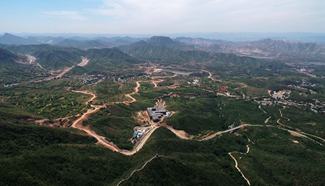UNITED NATIONS, June 12 (Xinhua) -- To mark World Day Against Child Labor, two United Nations agencies have launched an e-learning course to ensure child labour prevention measures included in agricultural and rural development programs, particularly those targeting poor smallholders.
"To achieve zero hunger, we must also achieve zero child labor," said Jose Graziano da Silva, director-general of the UN Food and Agriculture Organization (FAO), which designed the course along with the International Labour Organization (ILO).
"Child labor is certainly a complex issue, and it cannot be tackled alone. We need strong partnerships, where everyone brings expertise and resources to the table," da Silva said in remarks to mark the World Day Against Child Labor, which is observed annually on June 12.
The End Child Labor in Agriculture e-course covers the sectors of crops, livestock, forestry, fisheries and aquaculture.
Specifically, it consists of 15 lessons, ranging from about 30 to 65 minutes each, grouped into seven units: introduction to child labour in agriculture; identifying and coordinating stakeholders; assessing and generating data and knowledge; incorporating child labour in policies and strategies; addressing child labour in agricultural programs; monitoring, evaluating and reporting; and developing capacity and communicating effectively.
FAO and ILO noted that globally, nearly 60 percent of all child labourers -- almost 100 million girls and boys -- work in agriculture. The worse forms of child labour include hazardous work that can harm their health and safety.
Da Silva highlighted that agricultural policies and programs can play a unique role in addressing the root causes of child labour, and should be combined with adequate education systems that meet the needs of children and youth in rural areas.
Together with social protection, and decent work policies for rural youth and adults, "we have the basic ingredients needed to end child labour in agriculture," he said.
Along those lines, Guy Ryder, the ILO director-general, underscored that rural children should expect to benefit from quality education and decent work opportunities in their communities.
"Our e-learning course sends a clear message that it is imperative to end child labor in agriculture. This tool will help to build the capacity of agricultural stakeholders as well as labour stakeholders -- and others -- to fully engage where they can best contribute," he said.
The new e-course addresses the need to implement labour-saving technologies to reduce demand for child labour as well as safer agricultural practices to reduce hazardous working conditions.
The agencies highlighted that an action as simple as properly training oxen used to plough can make a difference. In some places, where oxen are not well-trained, children are harnessed in front of them as guides, they noted.
In addition, FAO and ILO emphasized that in many countries, children are commonly engaged in weeding. Technologies and practices that save time required for weeding -- for example, systems of rice intensification using row planting combined with mechanical weeders -- can therefore decrease the demand for child labor.
The course was co-funded by the government of the Netherlands. It is currently available in English and will soon be available in French and Spanish, the agencies said.
ILO launched the World Day Against Child Labor in 2002 to focus attention on the global extent of child labor and the action and efforts needed to eliminate it.
Each year on June 12, the World Day brings together governments, employers and workers organizations, civil society, as well as millions of people from around the world to highlight the plight of child laborers and what can be done to help them.
Around the world, large numbers of children are engaged in paid or unpaid domestic work in the home of a third party or employer. These children can be particularly vulnerable to exploitation. Their work is often hidden from the public eye, they may be isolated, and they may be working far away from their family home.
This year, the focus for World Day Against Child Labor is on child labour and supply chains. With 168 million children still in child labor, all supply chains, from agriculture to manufacturing, services to construction, run the risk that child labour may be present.
"Child labour has no place in well-functioning and well regulated markets, or in any supply chain. The message that we must act now to stop child labour once and for all has been affirmed by the Sustainable Development Goals," Guy Ryder, the ILO director-general, said, referring to the 17 global development targets for the next 15 years. "Acting together, it is within our means to make the future of work a future without child labour."










